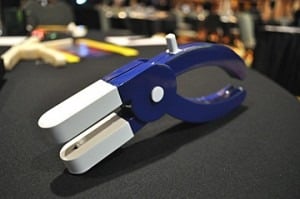Undergraduate FastStitch team wins again

FastStitch, a suturing device developed by BME undergraduates, was selected as the winner in the therapeutic devices category of the National Institute of Biomedical Imaging and Bioengineering (NIBIB) DEBUT Challenge. The BME student team will be honored at the NIBIB DEBUT Challenge award ceremony during the 2012 Annual Meeting of the Biomedical Engineering Society (BMES) in Atlanta, GA, in late October 2012. The team will receive $10,000 and each team member will receive up to $2,000 toward the travel and registration costs to attend the award ceremony.
NIBIB’s mission is to improve health by leading the development and accelerating the application of biomedical technologies. The DEBUT Challenge is open to undergraduate students working on the development of innovative solutions to unmet health and clinical problems in one of three categories: Diagnostic Devices/Methods, Therapeutic Devices/Methods, Technology to Aid Underserved Populations and Individuals with Disabilities.
In addition to the NIBIB award, the FastStitch student team has raised more than $80,000 in grant and prize funds to move the project forward. Other wins include first place in the University of California, Irvine, and University of Maryland business plan competitions and in the ASME International Innovation Showcase.
The FastStitch suturing device, described by the student inventors as a cross between a pliers and a hole puncher, is a disposable suturing tool created to guide the placement of stitches to guard against the accidental puncture of internal organs. Although still in the prototype stage, the purpose of FastStitch is to improve the way open abdominal surgeries are conducted.
The project began as a biomedical engineering course assignment for eight Johns Hopkins students over the past school year. The students were asked to design and test a tool that would improve the way surgeons stitch together the strongest part of the abdomen, the muscle layer called the fascia, which is located just below the patient’s skin. Team member Luis Hererra, a sophomore biomedical engineering major, stated that “Doctors who have to suture the fascia layer say it can be like pushing a needle through the leather of your shoe.” Herrera further states that “If the needle accidentally cuts into the bowel, it can lead to a sepsis infection that can be very dangerous.” To prevent this, the students designed the FastStitch needle to remain housed within the jaws of the stitching tool. “You place the fascial layer between the top and bottom arms of the device,” said Sohail Zahid, leader of the student team. “Then, as you close the arms, the spring-loaded clamp is strong enough to punch the needle through the fascial layer. When this happens, the needle moves from one arm of the tool to the other.”
In addition to Zahid and Herrera, other team members include Anvesh Annadanam, Haley Huang, Leslie Myint, Daniel Peng, Andy Tu, Stephen Van Kootyen, Dr. Hein Nguyen, assistant professor of surgery in the JHU School of Medicine, who served as the student’s clinical advisor during the development of FastStitch, and Dr. Robert Allen, associate research professor in the Department of Biomedical Engineering.
